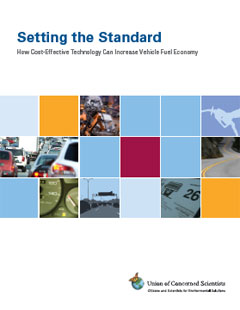The federal agency writing regulations for vehicle fuel economy standards could lay the groundwork for a new vehicle fleetwide average of more than 50 miles per gallon by 2030, according to a 2008 report from the Union of Concerned Scientists (UCS). The regulations mark the first phase of implementing standards passed by Congress in the energy bill in December 2007.
The energy bill requires the Department of Transportation's National Highway Traffic Safety Administration (NHTSA) to set fuel economy standards so the fleet average reaches at least 35 mpg in 2020, and requires NHTSA to make consistent progress towards that minimum starting in 2011. Additionally, by law, NHTSA must further strengthen the standards if it determines that higher, "maximum feasible" fuel economy levels are achievable.
Historically, NHTSA has used cost-benefit analyses to assess maximum feasible fuel economy levels, though in doing so, it incorporated flawed assumptions resulting in erroneous findings. In a fuel economy rulemaking released in 2006, for example, the agency assumed gasoline costs that significantly underestimated consumer savings. Further, it placed a monetary value of reduced global warming pollution at zero, suggesting that there are no economic benefits to avoiding the worst consequences of climate change. In November 2007, the Ninth Circuit Court of Appeals ruled that NHTSA's approach was arbitrary and capricious, and ordered the agency to revisit the standards.
According to UCS's report, NHTSA could set cost-effective fleet average fuel economy standards nearing 40 mpg by 2020, a target achievable even without hybrid technology. With a modest 25 percent hybrid market share in 2020, a fleet average fuel economy of 42 mpg could be achieved, while increased sales of fuel-efficient hybrids could lift the average even higher.
In what represents the first comprehensive review of a number of government, academic and nonprofit institution studies on fuel economy technology, UCS conducted cost-benefit analyses to determine realistic ranges for a potential fuel economy rule. The studies UCS examined ranged from reports by the National Academy of Sciences to UCS itself. The chief differences among the studies include varying assumptions about hybrid technology and the use of high-strength, lightweight materials.
When calculating the benefits of fuel economy standards, the UCS report assumed a $2.61 per gallon price for gasoline, the average price from 2005 to 2007. Previous NHTSA analyses used overly conservative Energy Information Administration gasoline price forecasts of $1.96 per gallon to $2.16 per gallon through 2030. In April 2008, when the UCS study was released, the average price of regular gasoline surpassed $3.40 across the country.
The UCS report also calculated the benefit of reducing global warming pollution and increasing oil security. It used a carbon price of approximately $41 per ton of CO2, equivalent to $0.49 per gallon, and a conservative estimate for the benefit of increasing oil security of $0.35 per gallon. Both figures are in 2006 dollars.




